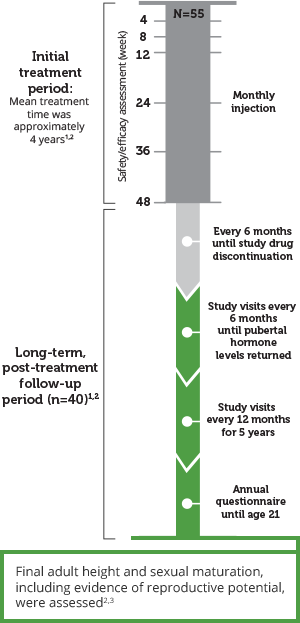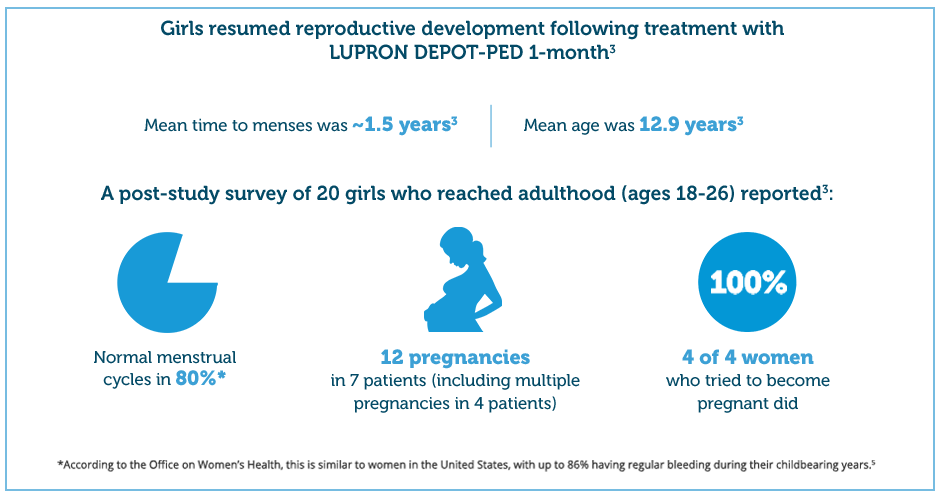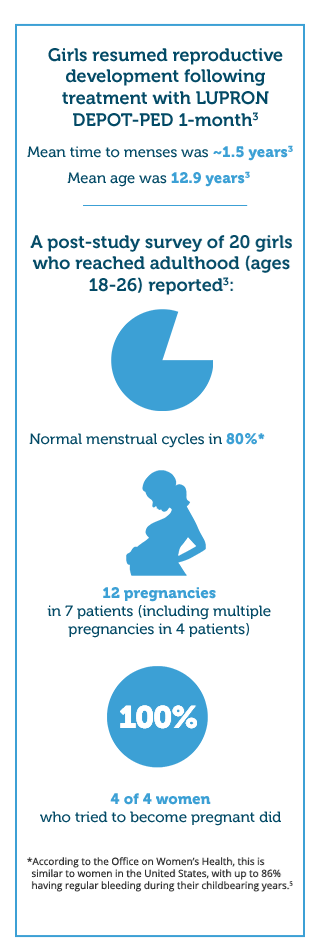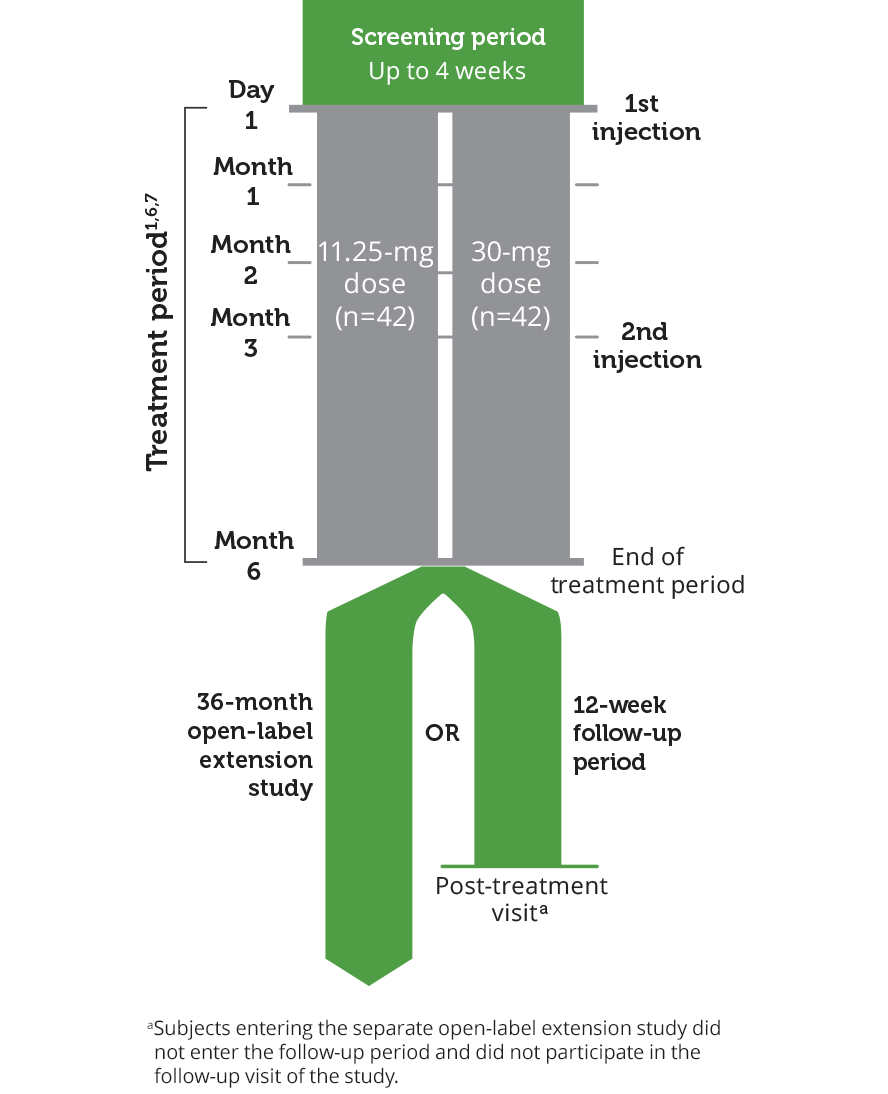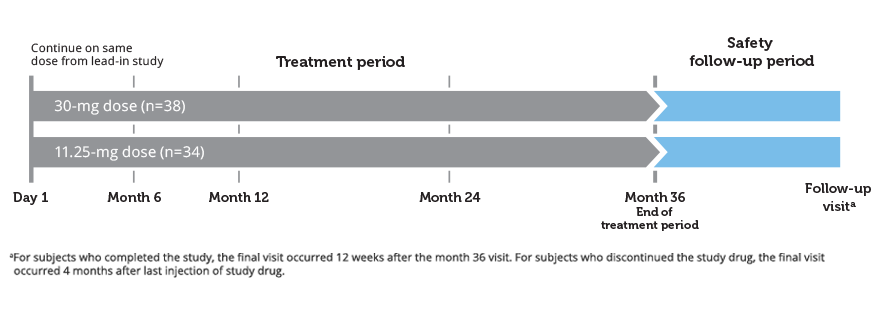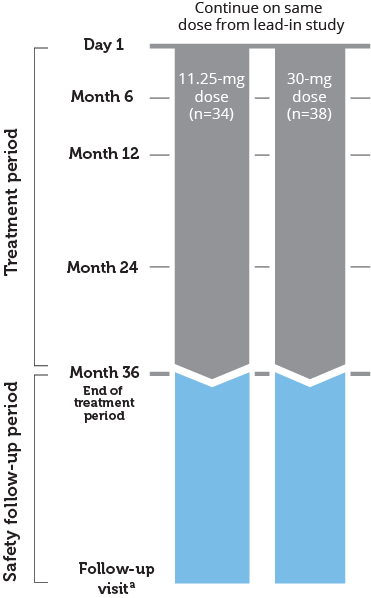1-MONTH ADMINISTRATION
IN A SINGLE, 18+ YEAR STUDY, LUPRON DEPOT-PED 1-MONTH DEMONSTRATED SUSTAINED, REVERSIBLE SUPPRESSION WITH FOLLOW-UP DATA THROUGH ADULTHOOD1-3
Study design for LUPRON DEPOT-PED 1-month
The LUPRON DEPOT-PED 1-month study was a prospective, multicenter, longitudinal study from 1991 to 2009 divided into 2 key phases: The open-label treatment period and the long-term, post-treatment follow-up period.2
| Primary endpoint1,3: Suppression of clinical sexual characteristics Secondary endpoints1,4: Gonadotropin concentrations, sex hormone concentrations, predicted mature height based on BA, ratio of BA to CA, growth rate, safety |
Results for LUPRON DEPOT-PED 1-Month
Suppression of clinical sexual characteristics, based on Tanner staging.
During 5 years of treatment
- 66.7% to 90.6% of females had suppression of breast development1
- 60% to 100% of males had suppression of genitalia development1
At 6 months post-treatment
- In females (n=35), Tanner breast stage 5 was achieved in:
— 78% of patients within the first 3 years3
— 100% of patients within 5 years3
- 4 of 5 males showed Tanner genital stage advancement by month 63
Secondary endpoint results for LUPRON DEPOT-PED 1-month
LUPRON DEPOT-PED 1-MONTH provided sustained suppression of mean peak LH, with hormone levels usually restored within 6 months of stopping treatment1
Mean peak LHa was suppressed throughout treatment and recovered after therapy1
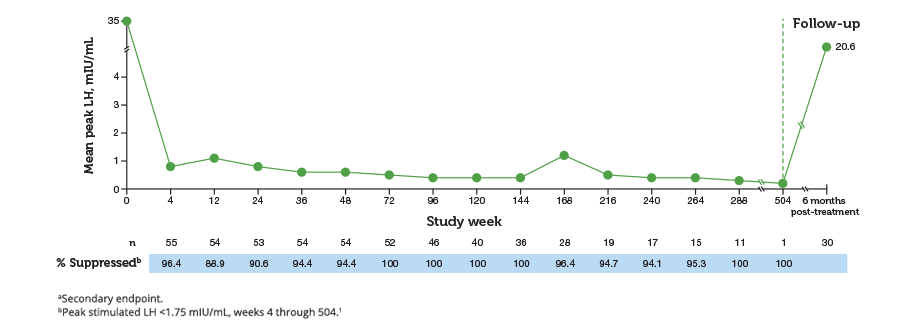
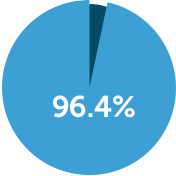
of patients achieved suppression by week 4 of treatment with LUPRON
DEPOT-PED1
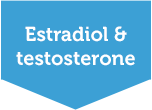
were suppressed to prepubertal levels
during the first 5 years of treatment1
Long-term study showed that growth and bone maturation normalized in patients treated with Lupron DEPOT-PED 1-month2
Mean incremental growth rate was greatly reduced from 10.6 cm/year at baseline to approximately
5-6 cm/year during the first 72 weeks of therapy and then 4-4.5 cm/year from week 72 to week 1922
Mean adult height
increased 4.0 cm
(n=30) over baseline
predicted adult height2
Advances in BA were delayed with LUPRON DEPOT-PED
treatment. The mean ratio of
BA to CA decreased from 1.5 at baseline to 1.1 by the end of treatment1
Patients essentially reached the mean height of the normal population by adulthood (mean height standard deviation score was -0.2 at adult height)1
Adverse Reactions for LUPRON DEPOT-PED 1-month
Adverse reactions occurring in ≥2% of pediatric patients receiving
LUPRON DEPOT-PED 1-month1:
| Adverse reaction | Percentage of patients (N=421) |
|---|---|
| Injection site reactions including absessa | 9 |
| Emotional lability | 5 |
| Headache | 3 |
| General pain | 3 |
| Acne/seborrhea | 3 |
| Rash including erythema multiforme | 3 |
| Vaginitis/vaginal bleeding/vaginal discharge | 3 |
| Vasodilation | 2 |
aMost events were mild or moderate in severity.
-
Select Safety Considerations
- LUPRON DEPOT-PED is contraindicated in patients who are hypersensitive to gonadotropin-releasing hormone (GnRH), GnRH agonists, or any of the product excipients or in females who are or may become pregnant during treatment, as LUPRON DEPOT-PED may cause fetal harm.
- Increased clinical signs and symptoms of puberty, including vaginal bleeding, may occur during the first weeks of drug therapy or after subsequent doses.
- Psychiatric events have been reported in patients taking GnRH agonists, including LUPRON DEPOT-PED. Postmarketing reports include symptoms of emotional liability, such as crying, irritability, impatience, anger, and aggression. Monitor for development or worsening of psychiatric symptoms during treatment.
3-Month Administration
SUSTAINED SUPPRESSION WITH LUPRON DEPOT-PED 3-MONTH1
Study Design for LUPRON DEPOT-PED 3-Month
Randomized, open-label clinical trial to assess the safety and efficacy of LUPRON DEPOT-PED 11.25 and 30 mg for 3-month administration in 84 subjects (n=76 females, n=8 males) with CPP between 1 and 11 years of age1
- Efficacy was measured as the suppression of peak stimulated LH to <4.0 mIU/mL, assessed at months 2, 3, and 61
- Both treatment groups had equal numbers of treatment-naïve and previously treated patients1
Primary endpoint7: Secondary endpoints1,7: |
Secondary endpoint results for LUPRON DEPOT-PED 3-month
LUPRON DEPOT-PED 3-MONTH 30-MG DOSING SUPPRESSED LH CONCENTRATIONS TO <4.0 mIU/mL AT 1 MONTH AND PROVIDED SUSTAINED SUPPRESSION AT MONTHS 2, 3, AND 61
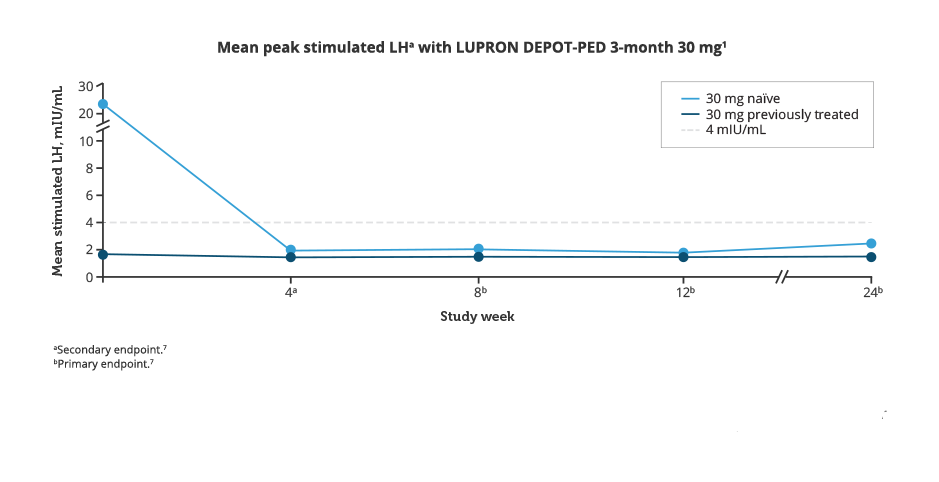
LUPRON DEPOT-PED 3-month 11.25 mg suppressed LH concentrations to <4.0 mlU/mL from month 1 through month 6 for previously treated patients and at month 3 through month 6 for those who were treatment-naïve.1
Suppression of peak stimulated LH <4.0 mIU/mLa from month 2 through month 6
with LUPRON DEPOT-PED 3-month 30 mg1
Percent with suppression
Treatment-naïve (n=21)

95% CI (%)c:
69.6, 98.8
Previous treatmentb (n=21)

95% CI (%)c:
83.9, 100
Total (n=42)

95% CI (%)c:
83.8, 99.4
aPrimary endpoint.
bPreviously treated with GnRHa for at least 6 months prior to enrollment in the study.
cTwo-sided 95% CI.
Suppression of peak stimulated LH <4.0 mIU/mL from month 2 through month 6 with LUPRON DEPOT-PED 3-month 11.25 mg was 76.2% for treatment-naïve patients (n=21; 95% CI: 52.8, 91.8), 81% for previously treated patients (n=21; 95% CI: 58.1, 94.6), and 78.6% for the total number of patients (N=42; 95% CI: 63.2, 89.7)1.
All LUPRON DEPOT-PED 1-month doses were represented in the previously treated patient population.8
Disposition of previously treated patients in the 3-month 30-mg dosing study group (n=21)8,a
| Prestudy dose | 30 mg every 3 months, No. |
|---|---|
| 7.5 mg for 1 month | 8 |
| 11.25 mg for 1 month | 6 |
| 15 mg for 1 month | 3 |
| 11.25 mg for 3 monthsb | 4 |
| Treatment failures | 0 |
aPreviously treated with GnRHa for at least the 6 months prior to study enrollment. Dosing was randomized for both prestudy and study treatments.
bThis formulation was not approved to treat CPP at the time of the study.
- 100% (42/42) of patients had sex steroid suppression to prepubertal levels† at all visits with LUPRON DEPOT-PED 30 mg for 3-month administration1
- 93% (39/42) of patients had sex steroid suppression to prepubertal levels† at all visits with LUPRON DEPOT-PED 11.25 mg for 3-month administration1
†Estradiol <20 pg/mL or testosterone <30 ng/dL.7
OPEN-LABEL EXTENSION STUDY FOR LUPRON DEPOT-PED 3-MONTH
Study design for LUPRON DEPOT-PED extension study6
Phase 3, open-label, multicenter extension study
Objective: Assess the long-term safety of continued treatment with LUPRON DEPOT-PED 3-month over 36 months of treatment in children with CPP.
- Objective included the maintenance of LH suppression and the effects on pubertal symptoms, sex steroid levels, and bone age
Study population:
- Included 65 female and 7 male subjects with CPP
- Ranged from 2–11 years of age at the beginning of the pivotal 6-month study
- Subjects had received 6 months of LUPRON DEPOT-PED at doses of 11.25 mg (n=34) or 30 mg (n=38) every 3 months during the pivotal study
- Patients continued the same treatment in this 36-month extension study
- All subjects had successfully completed the pivotal 6-month lead-in study with maintained LH suppression
Patients completing and discontinuing6
- 24 subjects completed the 36-month treatment period
- 48 subjects discontinued treatment during the study
- The most common resason for discontinuation of treatment was that the individual was considered ready to progress through physiologic puberty
RESULTS FOR LUPRON DEPOT-PED 3-MONTH 30 MG
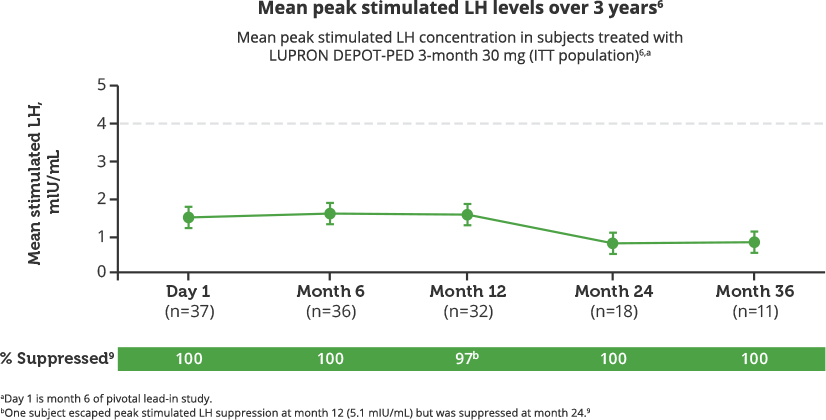
RESULTS FOR LUPRON DEPOT-PED 3-MONTH 11.25 MG
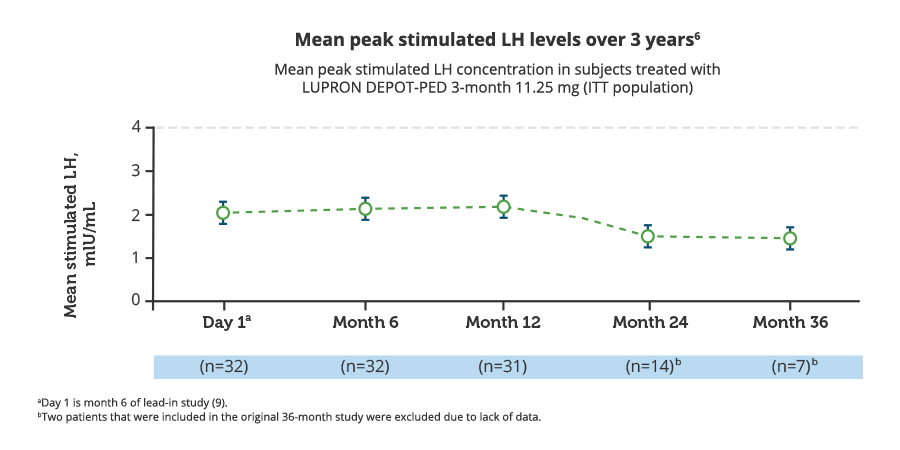
ADVERSE REACTIONS FOR LUPRON DEPOT-PED 3-MONTH
Adverse reactions occurring in ≥2% of pediatric patients receiving
LUPRON DEPOT-PED 3-month1:
| Adverse reaction | % of patients 11.25 mg (n=42) |
% of patients 30 mg (n=42) |
% of patients |
|---|---|---|---|
| Injection site pain | 19 | 21 | 20 |
| Weight increased | 7 | 7 | 7 |
| Headache | 2 | 7 | 5 |
| Mood altered | 5 | 5 | 5 |
| Injection site swelling | 2 | 2 | 2 |
-
Select Safety Considerations
- Convulsions have been observed postmarketing in patients taking GnRH agonists, including LUPRON DEPOT-PED, with or without a history of seizures, epilepsy, cerebrovascular disorders, central nervous system anomalies or tumors, and in patients on concomitant medications that have been associated with convulsions, such as bupropion and selective serotonin reuptake inhibitors (SSRIs). Convulsions have also been reported in patients in the absence of any of the conditions mentioned above.
- Pseudotumor cerebri (idiopathic intracranial hypertension) have been reported in pediatric patients receiving GnRH agonists, including LUPRON DEPOT-PED. Monitor patients for signs and symptoms of pseudotumor cerebri, including headache, papilledema, blurred vision, diplopia, loss of vision, pain behind the eye or pain with eye movement, tinnitus, dizziness, and nausea.
- Diagnostic tests of pituitary gonadotropic and gonadal functions may be affected when conducted during treatment and up to 6 months after discontinuation.
6-month administration
THE EFFICACY OF LUPRON DEPOT-PED 6-MONTH WAS EVALUATED FOR A YEAR IN AN OPEN-LABEL, SINGLE-ARM, MULTICENTER CLINICAL TRIAL1
Study Design for LUPRON DEPOT-PED 6-Month1
- 45 mg dose was administered as an intramuscular injection at 2 intervals 24 weeks apart
- 45 pediatric patients with CPP
- 27 patients treatment-naïve to GnRHa therapy
- 18 patients previously treated with GnRHa therapy
- Previous GnRHa therapies included 1-, 3-, 6-, and 12-month options

Primary endpoint1: Secondary endpoints10: |
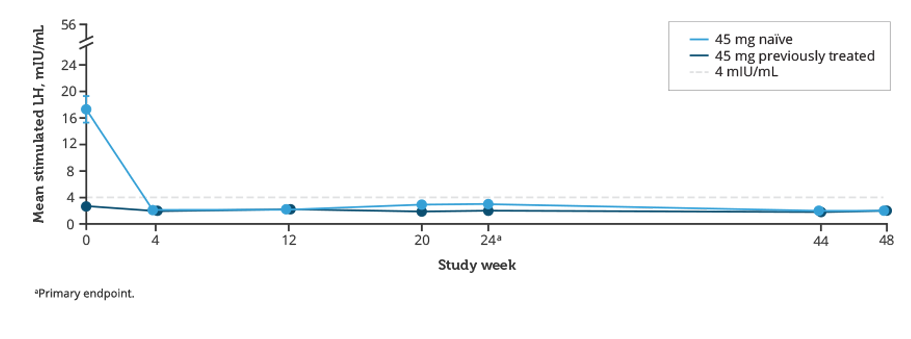
Suppression of peak stimulated LH <4.0 mIU/mL at week 241
Percent with suppression
Treatment-naïve (n=27)

95% CI (%):
Previously treateda (n=18)

95% CI (%):
72.7, 99.9
Total (N=45)

95% CI (%):
73.2, 95.0
aPreviously treated with other GnRHa formulations.
Persistent suppression of LH was demonstrated throughout the duration of the study10
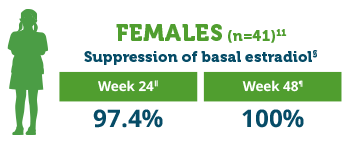
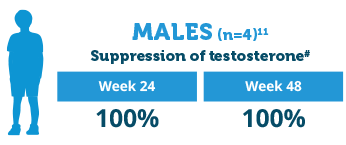
§Suppression of basal estradiol to <20 pg/mL.1
||At week 24, 38 patients were evaluated; 37/38 achieved suppression of basal estradiol.11
¶At week 48, 40 patients were evaluated; 40/40 achieved suppression of basal estradiol.11
#Suppression of testosterone to <30 ng/dL.1
PHYSICAL SIGNS OF PUBERTY IN MOST PATIENTS1**
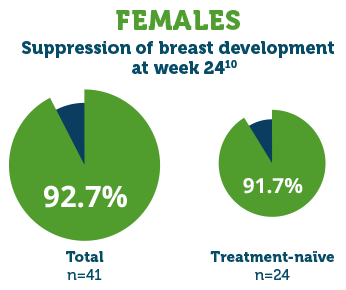
94.1% of previously treated females achieved
suppression of the physical signs of puberty.
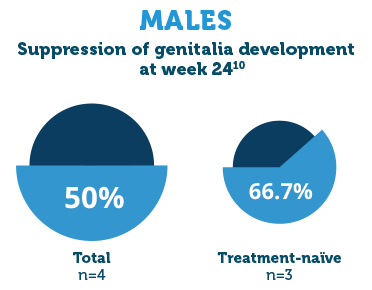
The 1 previously treated male in the study did not
achieve suppression of the physical signs of puberty.
**Suppression was defined as regression or no change in the physical signs of puberty.10
Mean height velocity in treatment-naïve patients and in previously treated patients10
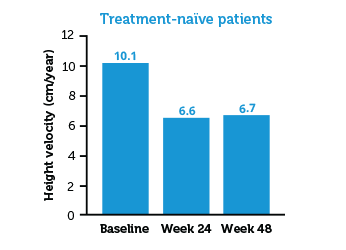
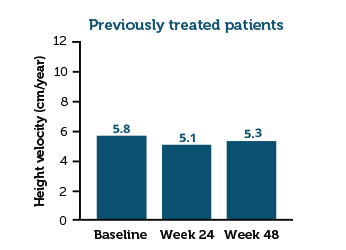
Ratio of bone age to chronological age decreased compared to baseline1

of patients had a decrease in the ratio of BA to CA
compared to baseline
ADVERSE REACTIONS FOR LUPRON DEPOT-PED 6-MONTH
Adverse reactions occurring in ≥4% of pediatric patients with CPP receiving
LUPRON DEPOT-PED 6-month1:
| Adverse reaction | Total (N=45) n (%) |
|---|---|
| Injection site reactionsa | 35 (78) |
| Headacheb | 15 (33) |
| Psychiatric eventsc | 10 (22) |
| Adomnial paind | 8 (18) |
| Diarrheae | 7 (16) |
| Hemorrhagef | 6 (13) |
| Nausea and vomiting | 6 (13) |
| Pyrexia | 6 (13) |
| Pruritusg | 5 (11) |
| Pain in extremity | 4 (9) |
| Rash | 3 (7) |
| Back pain | 3 (7) |
| Ligament sprain | 3 (7) |
| Weight increased | 3 (7) |
| Fractureh | 2 (4) |
| Breast tendernessi | 2 (4) |
| Insomniaj | 2 (4) |
| Chest pain | 2 (4) |
| Hyperhidrosis | 2 (4) |
aInjection site reactions include the preferred terms injection site pain, injection site erythema, injection site reaction, injection site warmth, injection site bruising, injection site discomfort, and injection site swelling.
bHeadache includes the preferred terms headache and cluster headache.
cPsychiatric events include the preferred terms affect lability, affective disorder, aggression, crying, depressed mood, disruptive mood dysregulation disorder, hallucination auditory, mood altered, mood swings, and trichotillomania.
dAbdominal pain includes the preferred terms abdominal pain, abdominal pain upper, and abdominal discomfort.
eDiarrhea includes the preferred terms gastroenteritis and diarrhea.
fHemorrhage includes the preferred terms contusion, epistaxis, hematochezia, and injection site bruising.
gPruritus includes the preferred terms pruritus, vulvovaginal pruritus, and nasal pruritus.
hFracture includes the preferred terms ankle fracture and tibia fracture.
iBreast tenderness includes the preferred terms breast pain and breast tenderness.
jInsomnia includes the preferred terms initial insomnia and insomnia.
No patients discontinued due to adverse reactions with the 6-month dosing schedule10




